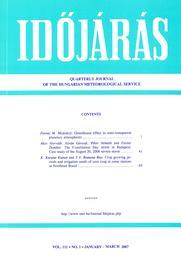Időjárás - Quarterly Journal of the Hungarian Meteorological Service (OMSZ)
Vol. 111, No. 1 * Pages 1–77 * January - March 2007
 |
|
Greenhouse effect in semi-transparent planetary atmospheres
Miskolczi Ferenc
idojaras.2007.1.1 (pp. 1–40)
Miskolczi Ferenc
idojaras.2007.1.1 (pp. 1–40)
The Constitution Day storm in Budapest: Case study of the August 20, 2006 severe storm
Ákos Horváth, István Geresdi, Péter Németh and Ferenc Dombai
idojaras.2007.1.2 (pp. 41–63)
Ákos Horváth, István Geresdi, Péter Németh and Ferenc Dombai
idojaras.2007.1.2 (pp. 41–63)
Crop growing periods and irrigation needs of corn crop at some stations in Northeast Brazil
Karuna Kumar, K., Ramana Rao, T. V.
idojaras.2007.1.3 (pp. 65–77)
Karuna Kumar, K., Ramana Rao, T. V.
idojaras.2007.1.3 (pp. 65–77)
IDŐJÁRÁS - Quarterly Journal

Az IDŐJÁRÁS a HungaroMet Nonprofit Zrt. negyedévenként megjelenő angol nyelvű folyóirata
Megrendelhető a journal.idojaras@met.hu címen.
A szerzőknek szánt útmutató itt olvasható.
Megrendelhető a journal.idojaras@met.hu címen.
A szerzőknek szánt útmutató itt olvasható.









